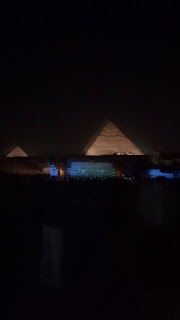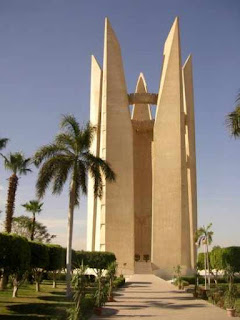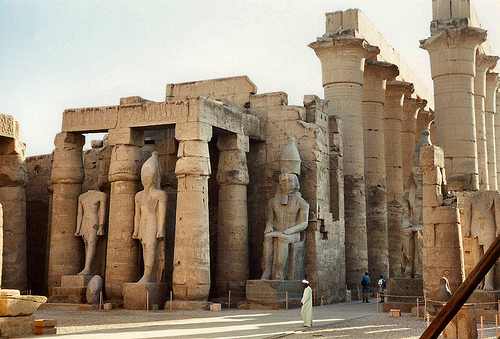The following is also probably one of the most important discoveries on
the planet ever. It’s happening right now at this moment. However, it began
about forty years ago with R.A. Schwaller de Lubicz. He’s a famous
self-educated Egyptian archaeologist who has written many books. He and
his stepdaughter, Lucie Lamy, have demonstrated a profound understanding
of sacred geometry and the Egyptian culture.
While observing the Sphinx, Schwaller de Lubicz became especially interested
in the tremendous wear on its surface. Toward the back of the
Sphinx there are wear patterns that cut twelve feet deep into its surface, and
this type of wear pattern is totally different from the patterns on other buildings in Egypt. The Wear Patterns on the other buldings, Supposedly built at the same time, are textured by sand and wind, which is consistent if the buildings are, as believed, around 4000 years old. But the wear patterns
on the Sphinx look like they’ve been smoothed with water.
According to mainstream thought, the Sphinx, the Great Pyramid and other associated
buildings were built about 4500 years ago in the Fourth Dynasty under
Cheops.
When this discrepancy was brought up to Egyptian archaeologists, they refused to listen. This went on for about forty years. Other people noticed it, but the Egyptians simply would not admit the obvious.
Then a man named John Anthony West became interested. He has written many books
on Egypt, including Serpent in the Sky and a fine Egyptian guidebook. When he heard about the Sphinx dispute, he went to look for himself. He could see that the wear was incredibly excessive and that it did look like water had caused the wear. He also found, like Schwaller de Lubicz, that he could
not get the accredited archaeologists to listen to his beliefs about the Sphinx.
On top of that, computers have calculated that it would take a minimum
of 1000 years of continuous, torrential rains dumped on the Sphinx nonstop for twenty-four hours a day—to cause that kind wear. This means the Sphinx has to be at least 8000 years old minimum. Because it’s not likely that it bucketed rain nonstop for 1000 years, they figured that it’s got to be at least 10- to 15,000 years old, maybe a lot older. When this evidence gets out to the world, it will be one of the most powerful revelations on this planet in a very, very long time. It’s going to have a bigger effect on the world’s view of itself than probably any other discovery. This evidence has
not entered the schools or general knowledge yet, though it has gone all around the planet. It has been looked at and checked out and thought about and argued over, and in the end most scientists have agreed that it cannot be doubted.
So the age of the Sphinx has now been put back to at least 10,000 years,
maybe 15,000 or a lot more, and it’s already changing the entire worldview
of the people on the cutting edge of archaeology. You see, judging by everything
we presently think we know, the oldest civilized people in the world
were the Sumerians, and they go back to approximately 3800 B.C. Before
that, conventional knowledge says there was nothing but hairy barbarians—
no civilization at all anywhere on the whole planet. But now we have
something man-made and civilized that’s 10,000 to 15,000 years old. That
changes everything!
In the past, when something new like this is discovered that has a major
influence on the viewpoint of the world, it takes about a hundred years for
it to get to the people, for the average person to say, “Oh, yes, that is true!”
But this time it’ll happen a lot quicker because of television, computers, the
Internet and the way things are today. Now scientific circles, for the first
time ever, are actually beginning to look at the words of Plato in a new light
when he talked about another culture, another continent, from a dim past
called Atlantis.
The Sphinx is the largest sculpture on the planet. It was not done by
hairy barbarians, but by a very sophisticated culture. And it was not done by
anybody we now know here on Earth. From a scientific point of view, this is
the first solid evidence to be accepted about the true age of civilization.
There has been lots of other evidence, but people just kept putting it under
the table. This information on the Sphinx has made a crack in our
worldview. This took place about 1990, and the crack is now widening.
We now have the accepted evidence that there absolutely had to have been
someone on Earth who was highly civilized as early as 10,000 years ago.
You can see how that’s going to completely change our view of who we
think we are.












































